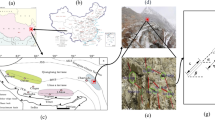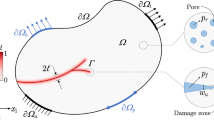Abstract
In addition to loading-induced damage, drying processes and temperature gradients may contribute considerably to the long term degradation of structures made of cementitious materials. In the paper, a 3D coupled thermo-hygro-mechanical model for concrete accounting for moisture- and heat transport, cracking and irreversible deformations and the various interactions between these processes is developed. The model is formulated on the basis of thermomechanics of partially saturated porous media in the sense of the Biot-Coussy theory. According to the coupled state equations arising from this theory, moisture and heat transport and the constitutive pre- and postcracking properties are coupled by means of macroscopic coefficients. They are determined by relating microscopic and macroscopic quantities and by exploiting symmetry relations associated with the existence of a macroscopic potential. The resulting model is based on a minimum of material parameters. As a representative example, a numerical simulation of the long-term degradation of an inner tunnel lining is described in the paper.
Résumé
En plus des dommages induits par les charges externes, les processus de séchage ainsi que les gradients de température peuvent considérablement contribuer à la dégradation à long terme des structures en matériaux à base de ciment. Cet article développe un modèle tridimensionnel thermo-hygro-mécanique pour le béton rendant compte du transport de chaleur et d'humidité, de la fissuration, des déformations irréversibles et des interactions diverses existant entre ces différents processus. Le modèle est élaboré à partir de la thermomécanique des milieux poreux partiellement saturés au sens de la théorie de Biot-Coussy. Selon les équations d'état couplées provenant de cette théorie, le transport de chaleur et d'humidité, les propriétés du comportement avant et après fissuration sont couplées par l'intermédiaire de coefficients macroscopiques. Elles sont déterminées en reliant les quantités microscopiques et macroscopiques et en exploitant les relations de symétrie associées à l'existence d'un potentiel macroscopique. Le modèle résultant est fondé sur un minimum de paramètres matériels. En guise d'exemple représentatif une simulation numérique de la dégradation à long terme du revêtement intérieur d'un tunnel est décrite dans l'article.
Similar content being viewed by others

References
Colina, H. and Acker, P., ‘Drying cracks: kinematics and scale laws’,Mater. Struct. 33 (2000) 101–107.
Sadouki, H. and Wittmann F.H., ‘Numerical investigations on damage in cementitious composites under combined drying shrinkage and mechanical load’, in R. de Borst, J. Mazars, G. Pijaudier-Cabot, and J.G.M. van Mier, editors, ‘Fracture Mechanics of Concrete Structures’, Vol. 1 (Balkema, 2001) 95–98.
Wittmann, F.H., ‘Surface tension, shrinkage and strength of hardened cement paste’,Mater. Struct. 1 (1968) 547–552.
Dahms, J., ‘Influence of moisture on the compressive strength of concrete (Einfluß der Eigenfeuchtigkeit auf die Druckfestigkeit des Betons)’,Beton 18 (1968) 361–365 [in German].
Pihlajavaara, S.E., ‘A review of some of the main results of a research on the ageing phenomena of concrete: Effect of moisture conditions on strength, shrinkage and creep of mature concrete’,Cement and Concrete Research,4 (1974) 761–771.
Bourgeois, F., Burlion, N. and Shao, J.F., ‘Modelling of elastoplastic damage in concrete due to desiccation shrinkage’,International Journal for Numerical and Analytical Methods in Geomechanics 26 (2002) 759–774.
Bažant, Z.P. and Raftshol, W.J., ‘Effect of cracking in drying and shrinkage specimens’,Cement and Concrete Research 12 (1982) 209–226.
Bažant, Z.P. and Wittmann, F.H., editors, ‘Creep and shrinkage of concrete structures’, (J. Wiley and Sons, Chichester, England, 1982).
CEB-FIP.Model Code 1990 (Design Code). CEB, 1990.
Ulm, F.-J., Rossi, P., Schaller, I. and Chauvel, D., ‘Durability scaling of cracking in HPC structures subject to hygromechanical gradients’,Journal of Structural Engineering (ASCE) 125 (1999) 693–702.
de Borst, R., Mazars, J., Pijaudier-Cabot, G. and van Mier, J.G.M., editors, chapter ‘Durability, time dependence and coupled problems’ (Balkema, 2001), 133–278.
Bangert, F., Grasberger, S., Kuhl, D. and Meschke, G., ‘Environmentally induced deterioration of concrete: physical motivation and numerical modeling’,Engineering Fracture Mechanics 70 (2003) 891–910.
Biot, M.A., ‘General theory of three-dimensional consolidation’,Journal of Applied Physics 12 (1941) 155–165.
Coussy, O., ‘Mechanics of Porous Continua’, (John Wiley & Sons, Chichester, 1995).
Coussy, O., Eymard, R. and Lassabatère, T., ‘Constitutive modeling of unsaturated drying deformable materials’,Journal of Engineering Mechanics (ASCE) 124 (1998) 658–667.
Bary, B., Bournazel, J.-P. and Bourdarot, E., ‘Poro-damage approach applied to hydro-fracture analysis of concrete’,Journal of Engineering Mechanics (ASCE) 126 (2000) 937–943.
Burlion, N., Bourgeois, F. and Shao, J.F., ‘Coupling damage—drying shrinkage: experimental study and modelling’, in V. Baroghel-Bouny and P.-C. Aïtcin, editors, Proceedings of the International RILEM Workshop on Shrinkage of Concrete, RILEM PRO 17 (RILEM Publications sarl, 2000).
Carmeliet, J. and Van Den Abeele, K., ‘Poromechanical modelling of shrinkage and damage processes in unsaturated porous media’, in V. Baroghel-Bouny and P.-C. Aïtcin, editors, Proceedings of the International RILEM Workshop on Shrinkage of Concrete, RILEM PRO 17 (RILEM Publications sarl, 2000).
Grasberger, S. and Meschke, G., ‘A hygro-thermalporoplastic damage model for durability analyses of concrete structures’, in ‘European Congress on Computational Methods in Applied Sciences and Engineering’, Barcelona, 2000, CD-ROM.
Meschke, G. and Grasberger, S., ‘Numerical modeling of coupled hygromechanical degradation of cementitious materials’,Journal of Engineering Mechanics (ASCE) 129 (4) (2003) 383–392.
Carmeliet, J., ‘A poroviscoelastic damage model for hygromechanical damage processes in unsaturated porous media, in R. de Borst, N. Bićanić, H. Mang, and G. Meschke, editors, ‘Computational Modelling of Concrete Structures’ (Balkema, Rotterdam, 1998) 559–566.
Grasberger, S. and Meschke, G. ‘Numerical simulation of coupled thermo-hygro-mechanical processes within concrete’, in Z.P. Bažant, F.-J. Ulm and F.H. Wittmann, editors, ‘Creep, Shrinkage and Durability Mechanics of Concrete and Other Quasi-Brittle Materials’, (Oxford, UK, 2001, Elsevier) 165–170.
Benboudjema, F., Meftah, F. and Torrenti, J.M., ‘A unified approach for the modeling of drying shrinkage and basic creep of concrete: analysis of intrinsic behaviour and structural effects’, in R. de Borst, H.A. Mang, N. Bićanić and G. Meschke, editors, ‘Computational Modelling of Concrete Structures’, (Balkema, 2003) 391–400.
Grasberger, S. and Meschke, G., ‘Drying shrinkage, creep and cracking of concrete: from coupled material modelling to multifield structural analyses’, in R. de Borst, H.A. Mang, N. Bićanić and G. Meschke, editors, ‘Computational Modelling of Concrete Structures’ (Balkema, 2003) 433–442.
Zoback, M.D. and Byerlee, J.D., ‘The effect of microcrack dilatancy on the permeability of westerly granite’,Journal of Geophysical Research 80 (1975) 752–755.
Bažant, Z.P., Sener, S. and Kim, J.K., ‘Effect of cracking on drying permeability and diffusivity of concrete’,ACI Materials Journal 84 (1987) 351–357.
Brodersen, K. and Nilsson, K., ‘Pores and cracks in cemented waste and concrete’,Cement and Concrete Research 22 (1992) 405–417.
Gérard, B., Breysse, D., Ammouche, A., Houdusse, O. and Didry, O., ‘Cracking and permeability of concrete under tension’,Mater. Struct.,29 (1996) 141–151.
Aldea, C.-M., Shah, S.P. and Karr, A., ‘Effect of cracking on water and chloride permeability of concrete’,Journal of Materials in Civil Engineering 11 (1999) 181–187.
Gérard, B. and Marchand, J., ‘Influence of cracking on the diffusion properties of cément-based materials. Part I: Influence of continuous cracks on the steady-state regime,Cement and Concrete Research 30 (2000) 37–43.
Breysse, D. and Gérard, B., ‘Transport of fluids in cracked media’, in H.W. Reinhardt, editor, ‘Penetration and Permeability of Concrete’, RILEM Report 16 (E & FN Spon, London, 1997) 123–153.
Bažant, Z.P., Hauggaard, A.B., Baweja, S. and Ulm, F.-J., ‘Microprestress-solidification theory for concrete creep. I: Aging and drying effects’,Journal of Engineering Mechanics (ASCE) 123 (1997) 1188–1194.
Bear, J. and Bachmat, Y., ‘Introduction to Modeling of Transport Phenomena in Porous Media’ (Kluwer Academic Publisher, Dordrecht, The Netherlands, 1991).
Ulm, F.-J. and Coussy, O. ‘Strength growth as chemo-plastic hardening in early age concrete’,Journal of Engineering Mechanics (ASCE) 122 (1996) 1123–1132.
Carmeliet, J., ‘Poroelastic damage model for unsaturated porous media: Part 1: Constitutive modelling’,International Journal of Solids and Structures (2000) submitted.
Schrefler, B.A. and Zhan, X., ‘A fully coupled model for water flow and airflow in deformable porous media’,Water Resources Research 29 (1993) 155–167.
Lewis, R.W. and Schrefler, B.A., ‘The Finite Element Method in the Static and Dynamic Deformation and Consolidation of Porous Media’ (John Wiley & Sons, Chichester, 1998).
Fillunger, P., ‘Soil mechanics? (Erdbaumechanik?)’ (Vienna, 1936) [in German].
von Terzaghi, K., ‘The shearing resistance of saturated soils and the angle between the planes of shear’, in First International Conference on Soil Mechanics, Vol. 1, Harvard University (1936) 54–56.
Biot, M.A. and Willis, D.G., ‘The elastic coefficients of the theory of consolidation,’Journal of Applied Mechanics 24 (1957) 594–602.
Nur, A. and Byerlee, J.D., ‘An exact effective stress law for elastic deformation of rock with fluids’,Journal of Geophysical Research 76 (1971) 6414–6419.
Bishop, A.W., ‘The influence of an undrained change in stress on the pore pressure in porous media of low compressibility’,Géotechnique 23 (1973) 435–442.
Bishop, A.W., ‘The principle of effective stress’,Teknisk Ukeblad,39 (1959) 859–863.
Bishop, A.W. and Blight, G.E., ‘Some aspects of effective stress in saturated and partly saturated soils’,Géotechnique 13 (1963) 177–197.
Alonso, E.E., Gens, A. and Josa, A., ‘A constitutive model for partially saturated soils’,Géotechnique 40 (1990) 405–430.
Coussy, O., ‘A general theory of thermoporoelastoplasticity for saturated porous materials’,Transport in Porous Media,4 (1989) 281–293.
Lydzba, D. and Shao, J.F., ‘Study of poroelasticity material coefficients as response of microstructure’,Mechanics of Cohesive-Frictional Materials,5 (2000) 149–171.
Meschke, G., Lackner, R. and Mang, H.A., ‘An anisotropic elastoplastic-damage model for plain concrete’,International Journal for Numerical Methods in Engineering 42 (1998) 703–727.
Meschke, G., ‘Consideration of aging of shotcrete in the context of a 3D viscoplastic material model’,International Journal for Numerical Methods in Engineering 39 (1996) 3123–3143.
Govindjee, S., Kay, G.J. and Simo, J.C., ‘Anisotropic modeling and numerical simulation of brittle damage in concrete’,International Journal for Numerical Methods in Engineering 38(21) (1995) 3611–3634.
Bažant, Z.P. and Najjar, L.J., ‘Nonlinear water diffusion in nonsaturated concrete’,Mater. Struct. 5 (1972) 3–20.
Snow, D.T., ‘Anisotropic permeability of fractured media’,Water Resources Research 5 (1969) 1273–1289.
von Smuda, J. and von Wolfersdorf, J., ‘On the finite element analysis of thermal and thermo-hygral problems in mechanical and civil engineering (Ein Beitrag zur Behandlung thermischer und thermisch-hygrischer Probleme im Maschinenbau und im Bauwesen mittels der Finite-Elemente-Methode)’, PhD thesis, Fakultät für Maschinenwesen, Technical University of Dresden, Germany, 1990, [in German].
Hellmich, Ch., ‘Shotcrete as part of the new Austrian tunneling method: from thermochemomechanical material modeling to structural analysis and safety assessment of tunnels’, PhD thesis Vienna University of Technology, Vienna, Austria, 1999.
Springenschmid, R. and Plannerer, M., ‘Cracks at the crowm of inner linings of large tunnels (Firstrisse in der Innenschale großer Tunnel—Ursachen und Wege zur Vermeidung)’,Beton- und Stahlbetonbau 92 (1997) 68–72, 109–112 [in German].
Grasberger, S., Neumann, M. and Meschke, G., ‘Computational durability mechanics of concrete structures and simulations of tunnel linings (Numerische Dauerhaftigkeitsanalysen von Betonstrukturen am Beispiel einer Tunnelinnenschale)’,Bauingenieur 78, (September 2003) 411–421 [in German].
van Genuchten, M.T., ‘A closed-form equation for predicting the hydraulic conductivity of unsaturated soils’,Soil Science Society of America 44 (1980) 892–898.
Baroghel-Bouny, V., Mainguy, M., Lassabatère, T. and Coussy, O., ‘Characterization and identification of equilibrium and transfer moisture properties for ordinary and high-performance cementitious materials’,Cement and Concrete Research 29 (1999) 1225–1238.
Rocznik, K., ‘Weather and climate in Germany: A meteorological, handbook (Wetter und Klima in Deutschland: Ein meteorologisches Jahreszeitenbuch mit aktuellen Wetterthemen)’ (Hirzel, Stuttgart, 1995).
Author information
Authors and Affiliations
Rights and permissions
About this article
Cite this article
Grasberger, S., Meschke, G. Thermo-hygro-mechanical degradation of concrete: From coupled 3D material modelling to durability-oriented multifield structural analyses. Mat. Struct. 37, 244–256 (2004). https://doi.org/10.1007/BF02480633
Received:
Accepted:
Issue Date:
DOI: https://doi.org/10.1007/BF02480633



